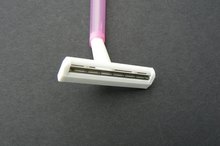How to Treat Folliculitis Over the Counter
When hair follicles become red, itchy and infected, folliculitis is the probable cause 1. Folliculitis can result from shaving, friction between the skin and clothing, excessive sweating or infected cuts or wounds 1. Superficial folliculitis, a condition in which the staph bacteria infects the hair follicles, often can be treated with over-the-counter products and remedies 1.
Keep the infected area clean by washing twice daily with antibacterial soap. Dirt and other contaminants may prohibit healing and lead to more serious infection.
How to Treat Infected Hair Follicles
Learn More
Apply warm compresses to the infected hair follicles up to three times a day. Run warm water on a soft washcloth, and squeeze out the excess water before applying. Heat can ease the pain and itching associated with folliculitis and helps the infected areas heal more quickly 1.
Make a more potent compress for pus-filled boils that may form as a result of folliculitis 1. Boil one quart of water, add one tsp. salt and set aside until lukewarm. Then apply the compress to help drain the boil.
What Are the Red Bumps on My Inner Thigh Growing Around?
Learn More
Relieve itching and inflammation with an over-the-counter hydrocortisone cream. This product is widely available in supermarkets, mass merchandisers and pharmacies. Use according to the directions on the package or as explained by your doctor.
Shave with an electric razor, if possible, to prevent further infection of the hair follicles. Electric razors provide a closer shave than razor blades, which reduces irritation. If you do not have an electric razor, use plenty of moisturizing shave cream or gel when shaving with a manual razor.
Prevent re-infection by keeping your towels and other personal items separate from those of the rest of your family. Wash towels in hot water to kill bacteria that may be present.
Warnings
If your folliculitis worsens, oozes or becomes very painful, visit your doctor. Deep folliculitis is a more severe form of the condition and may require antibiotic medications or prescription creams.
Related Articles
References
- Mayo Clinic folliculitis pages
- American Academy of Dermatology Association. Acne-like breakouts could be folliculitis.
- U.S. National Library of Medicine. MedlinePlus. Folliculitis. Reviewed October 8, 2018.
- Merck Manual Professional Version. Folliculitis, Revised September 2019.
- American Osteopathic College of Dermatology. Folliculitis.
- Fearfield, L.; Rowe, A.; Francis, N.; et al. "Itchy folliculitis and human immunodeficiency virus infection: clinicopathological and immunological features, pathogenesis and treatment." British Journal of Dermatology. 2009; 141(1):3–11.
- U.S. Department of Veteran Affairs. "Dermatologic Conditions: Primary Care of Veterans with HIV - Organ Systems and Metabolic." October 8, 2011; Washington, D.C.
Writer Bio
Erica Roth has been a writer since 2007. She is a member of the Society of Professional Journalists and was a college reference librarian for eight years. Roth earned a Bachelor of Arts in French literature from Brandeis University and Master of Library Science from Simmons College Graduate School of Library and Information Science. Her articles appear on various websites.









